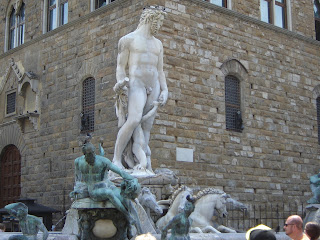Mark Twain would have done just fine had he hung around with me for my first trip to Firenze (Florence). Twain famously wrote in his
Altas travel letters (which later became the book
Innocents Abroad) that he did not want Michelangelo for breakfast, lunch, tea and dinner. My first sight of Florence's swarming abundance of art was tinged by a Twain-like irony.
At 8:30 a.m. we walked into the
Piazza de la Republica (1895) whose huge arches were masked by the temporary stage being set up for a Hard Rock cafe concert by the 1980s rock group
Simple Minds. Just above the towering stage was the
Piazza's grandiose prose proclaiming: "L'antico centro della città da secolare squallore a vita nuova restituto." (The old city center restored from secular squallor). But any hint of Twain's cynicism vanished in the next few minutes as we
arrived in the
Piazza della Signoria and caught our first sight of the huge Medici
palazzo and the "office buildings" contructed by Giorgio Vasari in 1560 for Cosimo de' Medici. This is the
Uffizi. Outside the museum is a sculpture gallery with beautiful copies of some of the most iconic statues in the world. It was tempting just to take photos of them-simulacra that they were.
 |
| La Fontana de Neptuno by Bartolomeo Ammannati (1560-75) |
We were a large group (15 participants, our directors Bill Stephany and Ron Herzman plus our art history specialist Christie Fengler-Stephany, and Lynn Kennison and her husband Wes, and family members of many participants). The guards were nervous at our number, but very accommodating. Pictures are not allowed in the gallery itself but here is one of two wonderful dog statues flanking the entrance to the first room.
The first room we entered (Room 2) houses three huge altarpieces from the late 13th century. Cimabue (c.1280)
Santa Trinita Maestà has the most Byzantine traces of the three. The
Rucellai Madonna by Duccio (1319), a Sienese, is elegant and more stylized and finally the
Ognizzanti Maestà by Giotto (1310) shows a Madonna and angels with clear person traits-gestures, emotion and a realistic physical presence. All three of these altar pieces were made during Dante's time and reflect a very radical shift in the way art, artists and people understood religion. The same shift is visible in Dante's works.
The works were overwhelming-but a solid pleasure remains. As my roommate Catherine noted, the salient figures were the women. From
Boticcelli's Primavera and
Birth of Venus, to
da Vinci's Annunciation, the most striking figures were these powerful, breathtakingly beautiful women.

We spent about two hours in the museum but did not get to even half of the rooms. A big surprise was being able to walk through the
Corridorio Vasariano that Cosimo had built across the Arno to avoid having to mingle with the people. It was studded with long, unobstructed views of the Arno and
Ponte Vecchio, and filled with majestic paintings.
The views from the corridor were stunning. Here is the
Ponte Vecchio -you can see that corridor running on the right side of the photo and across the top of the bridge.
 |
| Paintings line the Corridorio Vasariano |
On the walk, I paused to take photographs here of the wide Arno beneath us and some of the scores of paintings lining the wall.
The pictures provide a small idea of the grandeur and scale-but it was truly overwhelming. One can only wonder where Aristotle's idea of the golden mean was in all of this.
Happily, I discovered that goats were portrayed positively in several master works. Below is one particular painting- I believe this is by Benedetto Luti (1666-1724) though we were rushed and my notes are as scattered as were my thoughts at this time.
Outside was the poured concrete faux grotto that the Medici family constructed to have a cool space in summer. The dripping structure was reminiscent of Gaudi's Sagrada Familia church in Spain.
Naturally, I loved the inclusion of a whole flock of concrete sheep, and the lovely goats painted on the dome as if high on the slopes of a hill.
It was time to forage for some food of our own. We walked the short distance across the Ponte Vecchio to il due fratelli (the two brothers) panini shop and bought amazing sandwiches on the best bread that I have had so far. We split into smaller groups and explored the piazza by the Duomo and walked to the Academia were Michelangelo's 17 foot high David is housed. Unfortunately the museum was closed on Mondays so we will have to wait another day-perhaps we'll arrive there at tea time and toast Mr. Twain then.







